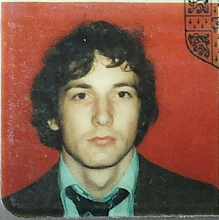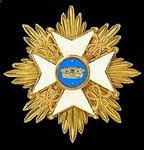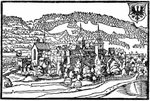Here are the flags of Prussian IR13:
Descended from a Huguenot unit raised in 1685, IR13 was in garrison in Berlin from 1724.
In 1750 Major General August Friedrich von Itzenplitz became Chef and made it one of the most strictly disciplined and famous (or infamous) of Prussian regiments. Its nickname was Donner und Blitzen - Thunder and Lightning. von Itzenplitz was not from a noble family and had in fact started in the Prussian army during the War of the Spanish Succession as a private, becoming ensign in 1715. He was to die on 5th February 1760 of wounds received at the battle of Kunersdorf.
At Lobositz October 1st 1756 IR13 was one of the units which cleared the Croats from the vineyards on the Lobosch hill after very heavy fighting, a decisive moment in the battle after several failed Prussian cavalry attacks had led Frederick to believe the battle was lost and had himself left the field. The Swiss writer Ulrich Bräker left an account of his involuntary stint in IR13, with a short but vivid account of the battle, including a description of the sensation of being under heavy artillery fire (not enjoyable, as you might guess). His account can be found here: http://www.keithsayers.id.au/Toggenburg/Cover.htm Towards the end of the fighting he managed to desert along with a number of friends and was given some money by the Austrians and sent on his way home to Switzerland. (This was very different treatment from that meted out to the surrendered Saxons by Frederick at Pirna shortly after, when almost all were forcibly enlisted in the Prussian army!)
At Prague May 6th 1757 the regiment was on the right wing and along with IR 17 was led by Prince Heinrich through the steep ravine of the Rokenitzer Bach on the northern edge of Mount Tabor and helped to seal the victory. We are told the diminutive Prince was nearly submerged in the stream and was then carried across on the shoulders of soldiers of IR 13. Another (rather contradictory!) story says that the Prince waded in and showed the reluctant soldiers that the stream was not as deep as they feared (Duffy, Army of Frederick the Great). This is the scene depicted by Carl Röchling in the image shown here:
(Note that, like Menzel, he shows the later almost bicorne-like tricorne rather than the correct tricorne for the period of the Seven Years War.)
Casualties were fairly heavy for the regiment.
IR 13 was lucky to miss Kolin but was in the first line at the relatively bloodless (for the Prussians!) victory of Rossbach on November 5th 1757. At Leuthen 5th December 1757 the 2nd battalion was in Wedell's advance guard that led the initial attack on the Kiefenberg at Sagschütz south of Leuthen, driving off three battalions of Württembergers at the point of the bayonet. The battalion lost about one-third killed and wounded in the battle, so it was certainly no pushover. The 1st battalion was in Bevern's command of Zieten's wing and took Gohlau, losing even more heavily than the 2nd battalion and suffering about two-fifths killed and wounded in the process.
In the 1758 campaign IR 13 was part of the King's army. In the Austrian attack on Frederick's camp at Hochkirch on 14th October the regiment was ordered by Field-Marshal Keith to drive the Austrians out of the village and attacked with IR18 under Prince Franz of Brunswick, who was killed. Heavy artillery fire drove them back to their supports, IR 30. Finally the Prussians were forced to retreat. In the battle IR13 lost 820 men or around three-quarters of the regiment and the Prussian army 9,000 or about one third of the army. Keith was also killed.
The regiment's Chef von Itzenplitz, who died of wounds on 5th February 1760, was replaced by Major General Friedrich Wilhelm von Syburg on February 8th.
At Liegnitz 15th August 1760 IR 13 was on the opposite side of the fight to Loudon's attack so had no casualties. It was part of Zieten's wing that belatedly won the battle of Torgau 3rd November 1760, near the end of the day just when it seemed the Austrians had won and Frederick had given up. Daun had already written an announcement of the victory to Vienna!
von Syburg was given command of IR16 on May 21st 1762 and so when the new Tsar Peter III made peace with Prussia and actually supplied troops to help Prussia (as Peter was a mad Prussophile) Frederick bestowed the order of the Black Eagle on Peter and made him Chef of IR13 on June 19th 1762. This was short-lived as Peter was assassinated on July 17th. Four days later at Burkersdorf on July 21st, where Frederick attacked a strongly entrenched Austrian army covering Schweidnitz, IR13 was part of Ramin's Corps which was ordered to demonstrate but not attack from the west to relieve pressure on the main attack from the east. Consequently it does not seem to have been engaged, as far as I can see, contrary to the accounts on the Kronoskaf website and in Dorn and Engelmann.
IR 13 was one of the most highly regarded regiments in the army; in 1768 "it was given the unique privilege of being rated immediately below the Garde and No.1 among the senior regiments of the army, regardless of the seniority of its Chef" (Duffy, Army of Frederick the Great).
And here is the uniform in 1756:




















